Critical Review
Understanding contemporary political and processes is impossible without learning their historical background; that is why sociology, history and political sciences are considered strongly connected with each other. Numerous researchers are carried out on the border of these disciplines. African-American study is one of the examples that illustrate this statement: this field of study requires one have significant background in history of Africa and the USA to understand contemporary processes that take place in the African-American community and in the World.
In this sense, the book by Naomi Chazan et al (1999) is a treasure for a student eager to succeed in getting familiarized with the issues of African-American studies, as well as for any other reader interested in this field. Chazan et al demonstrate an effective approach to delivering knowledge in African-American studies: the book offers a historical observation of political and social processes in Africa from the moment of the first movement of white settlements to the modern time. The authors make the effort to analyze and compare thus demonstrating common tendencies that took place throughout the continent. Particular attention is paid to the new era, the era of independence: the authors state that the contemporary political process in Africa is saturated and interesting; the problems of African countries are diverse but at the same time similar (3).
History of South Africa is a set of struggles and conflicts which have left their imprint on today’s independent state. The chapter 13 titled The Possibilities and Limits of Transforming State and Society helps a reader to understand the mentioned “possibilities” and “limits” from historical perspective. The aim of the chapter is studying causes, the course and consequences of struggles that took place in South Africa during 18th-20th century.
The focus of the chapter is political history of South Africa from the moment of coming of the first white settlers to the political processes that took place during the period of independence. However, political issues are not discussed in the isolation from those social: the authors allude to the social processes that accompanied actions of dominating powers. This approach is very effective, as the connection between these two fields in the real life is unquestionable.
The book addresses a broader range of issues than “what happened when”: the authors offer their answer on “why it happened”. This helps a student understand that every historical event has its underlying reason based on people’s interests and intents. Particularly, Chazan et al provide the observation of forces that tore South Africa apart for centuries; material and labor resources became the core of the struggle. We may see that whatever “newcomers” we talk about, each of the groups had its own interests that actually did not coincide with those of the native population and South Africa’s ecology. Contradiction of interests was the main ground for conflicts that, in turn, brought new suffering to the land. The authors emphasize that whatever sides took part in the defense of their interests – British versus Boer, the NP versus ANC – this perpetual struggle was saturated with the issues of racial superiority and inferiority.
The material of the chapter includes the emergence of the Boer community, coming of English-speaking whites, and the struggle between these two communities. The struggle for resources is inseparable from the struggle for the power. The book tells about the National Party’s aims and actions and describes the political competition between the British and the Afrikaners. Simultaneously, we observe the struggle of the black citizens for their equality and rights: this struggle becomes especially intense in 1970s. Then, we see how in accordance with the changes on the international scene the situation within South Africa also changes and observe the country’s first steps on its independent way.
The authors’ style of narration is close to that of a history textbook: Chazan et al do not focus on their own evaluation and commentary on history of South Africa; their own perception of the material is rather expressed in the way the information is organized and delivered. Providing the retrospective glance on the events in South Africa, Chazan et al illustrate their statements with statistics and authentic quotations that support them. The style is quite concise, and little attention is paid to the role of personality in history; a reader studying South Africa may continue research familiarizing with books that provide more personified version of the country’s history, such as, for example, Tom Lodge’s (2003) where Nelson Mandella is called “political saint in a new democracy” (1).
For a reader who is interested to advance his/her knowledge in history of South Africa, the study can be expanded by including cultural perspective into the focus. Politics, society and culture are connected and influence each other, and each stage of the country’s history marked by significant changes also brought significant changes to the cultural life of the community. Particularly, it is possible to recommend the book by Ala A. Abdi (2002) that offers us a historical view on culture in South Africa. For example, it would be rather interesting to combine the material on Afrikaners’ nationalism offered by Chazan et al with Abdi’s view on how it influenced culture and education in South Africa; both books also touch upon the contemporary multicultural society that exists and develops in South Africa.
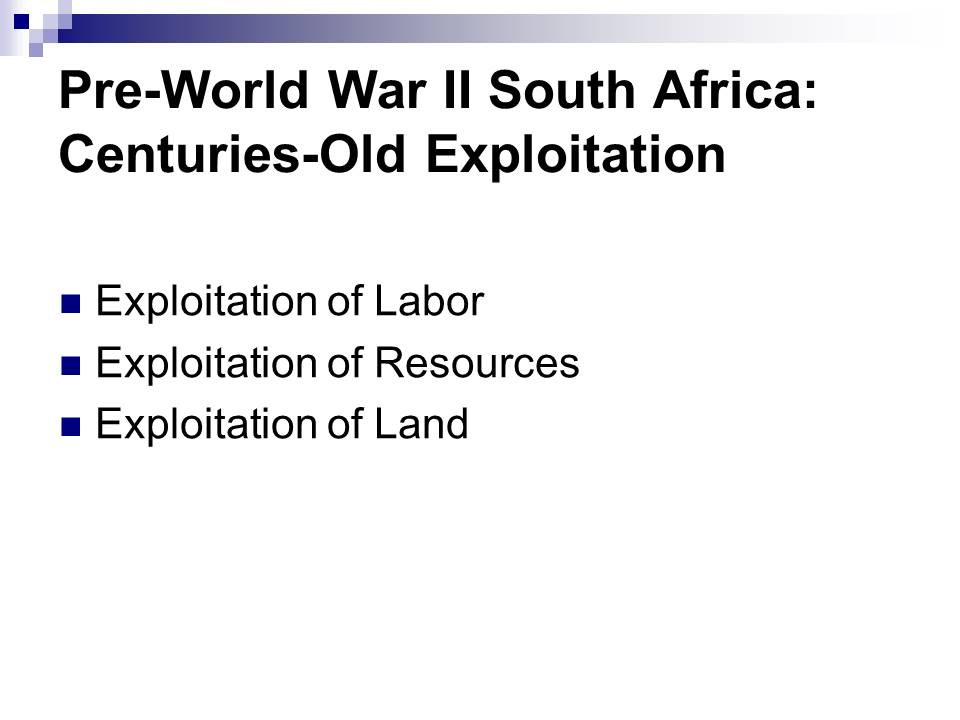
Who Are Boers?
Boer: Dutch or Afrikaner, Dutch-speaking settlers of South Africa (Cape Colony).
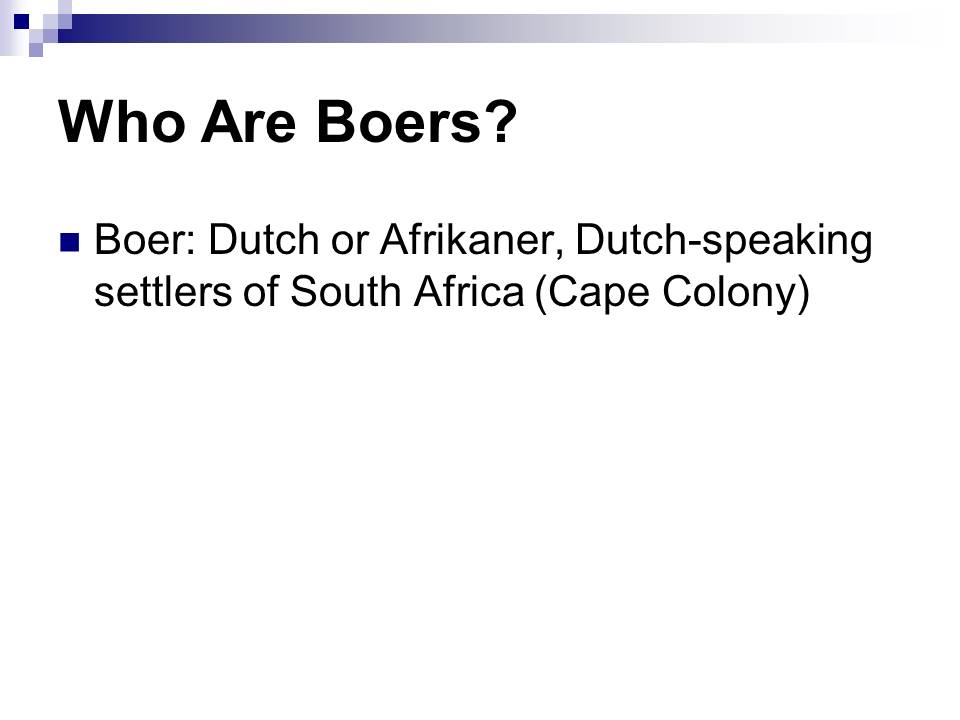
1860s-1880s: Diamonds and Gold. The New Round of Exploitation
Discovery of diamonds and gold created new opportunities for colonists’ wealth. “The exploitation of South Africa’s minerals was equaled only by the exploitation of labor” (Chazan et al 469).
- Extraction and production of minerals
- More labor needed
- More control needed
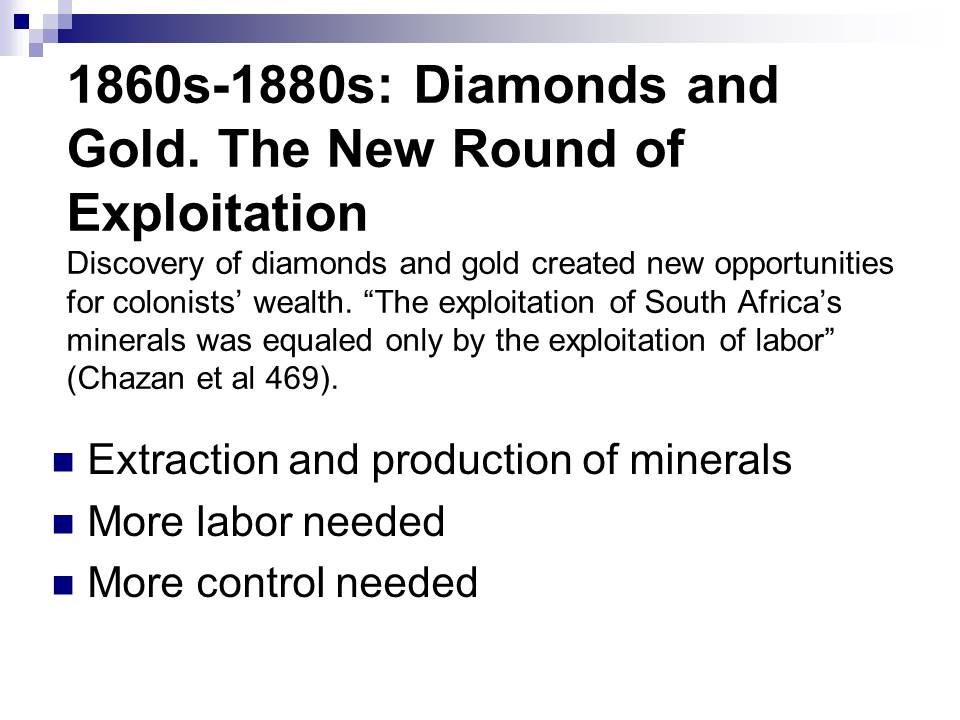
1913 Act: Winning over Land
93 per cent of South Africa’s land “for white purchase only” (Chazan et al 469).
African citizens have to concentrate on small territories.
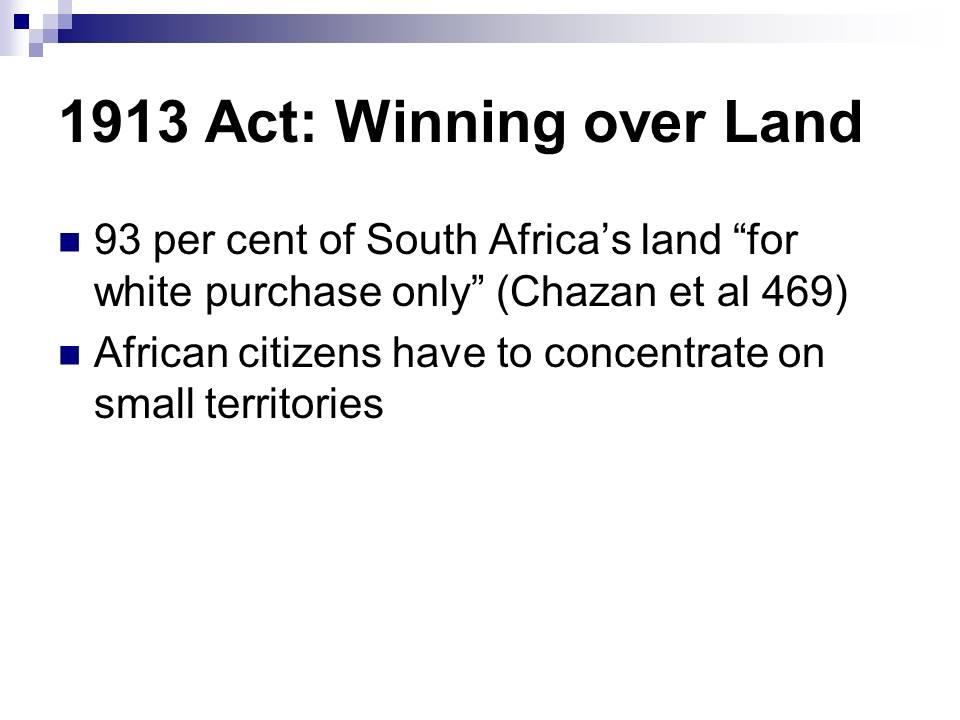
Boer War: Struggling for Wealth
British military intervention.
Struggle between the British and the Boer for the resources.
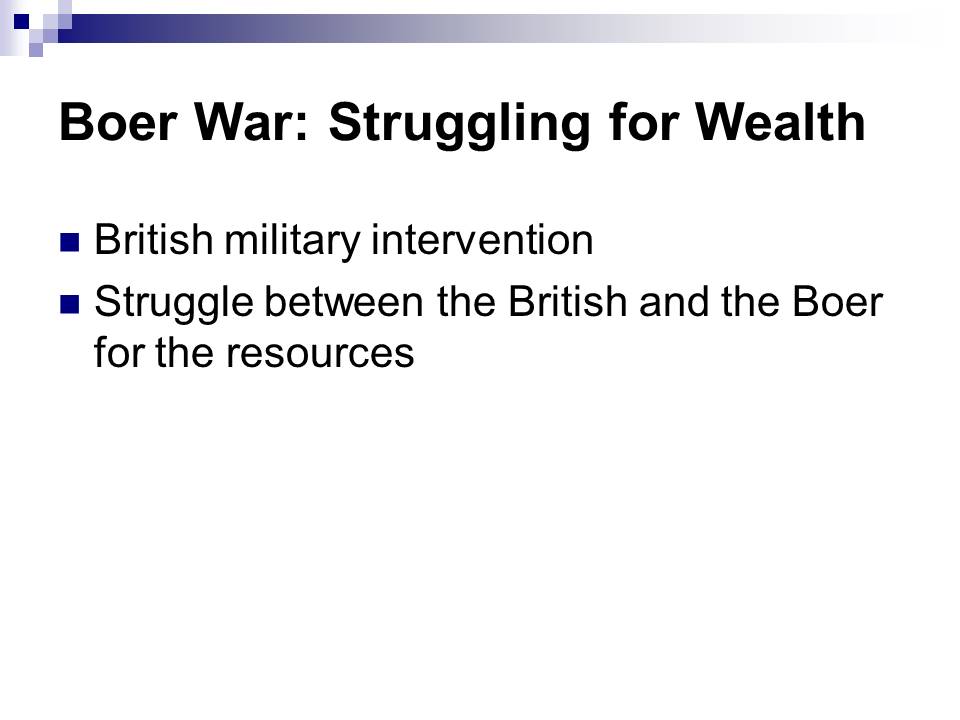
Changes in “Alignment of Forces”
Afrikaners’ status is inferior to English-speaking whites.
Necessity to “upgrade their own status.
Pinning hopes on National Party.
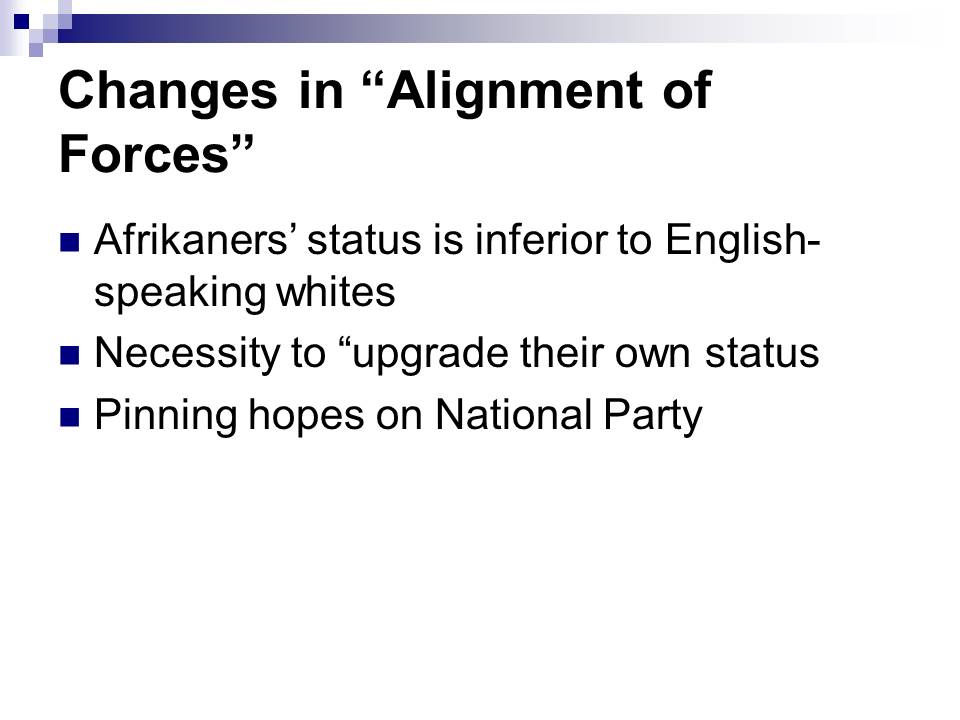
National Party: Aims
1948: Party won the plurality of seats.
Aims (Chazan et al 471):
- Advancement of segregation in the society.
- Maintenance of “white political supremacy” and all their privileges.
- Gaining parity of Afrikaners with the white English-speaking community in the fields of politics and economy.

National Party: Serving to the Interests of White Minority
Establishment of totalitarian police aimed at control and restrictions over the black population.
Segregation is aggravated by legislation.
5.8 million prosecutions in one decade.
The security of white South Africans came to rest on the insecurity of black South Africans (Chazan et al 471).
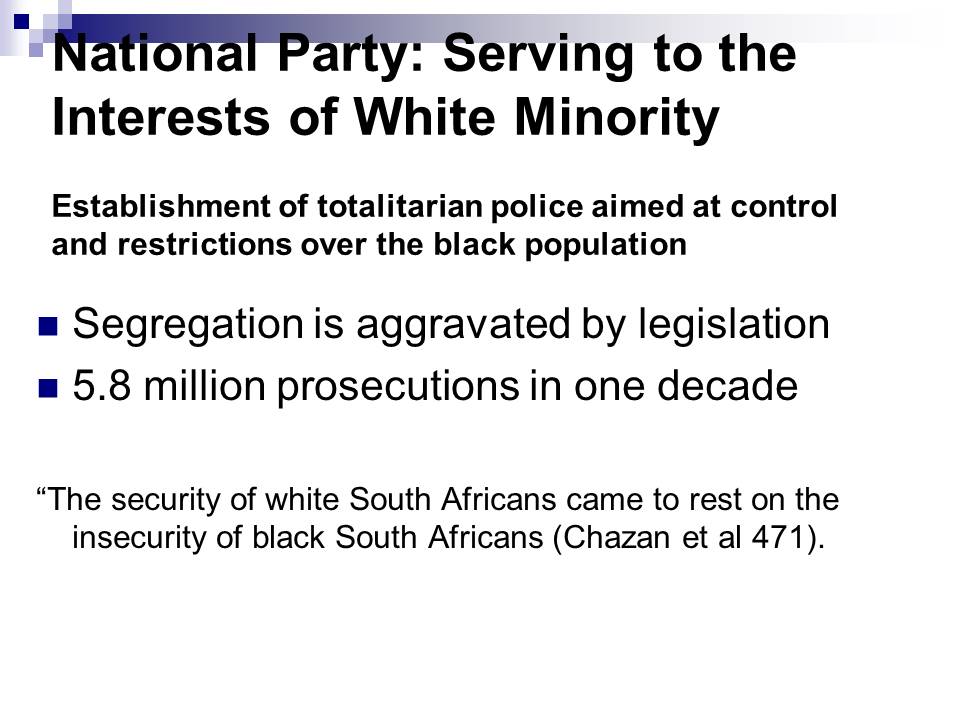
NP and Changes in the Society
Afrikaners: from agriculture to “white-collar” work 1970s: 90 per cent of state top executive and managerial positions are taken by Afrikaners (Chazan et al 472).
Afrikaners’ banks flourishing: increase of capital by 500 per cent (ibid.).
Support of Afrikaners’ business.
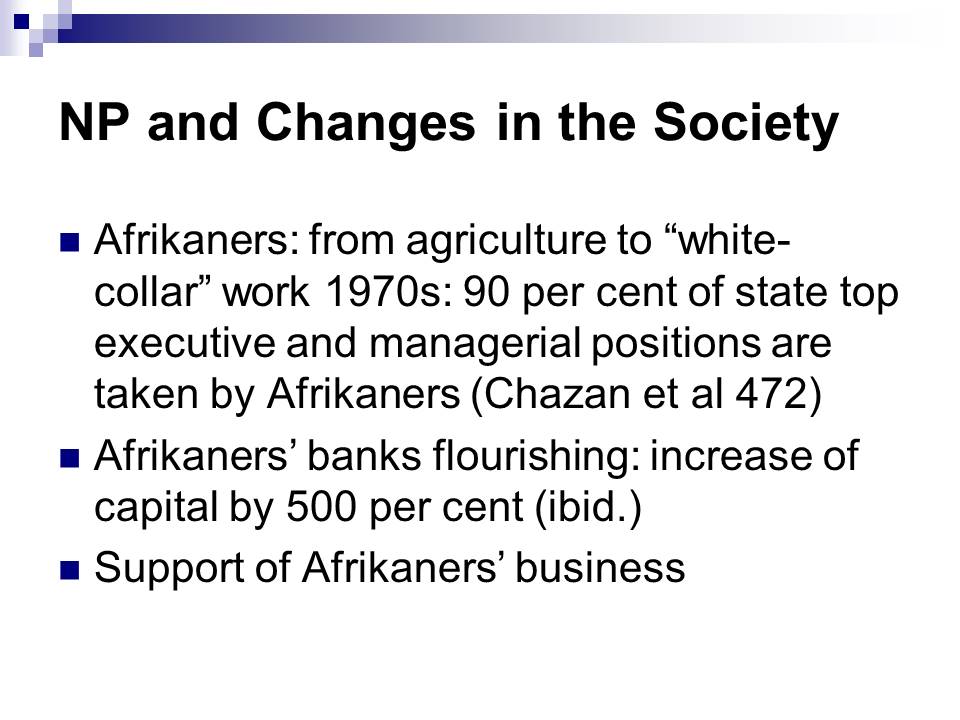
African National Congress and Communist Ideas
“We, people of South Africa, declare for all our country and the world to know: That South Africa belongs to all who live in it, black and white…” (Chazan et al 472).
Ideas of equality and equal rights spread.
NP: Suppression of Communism Act. Resistance to Communist ideas, arrests of ANC officials.
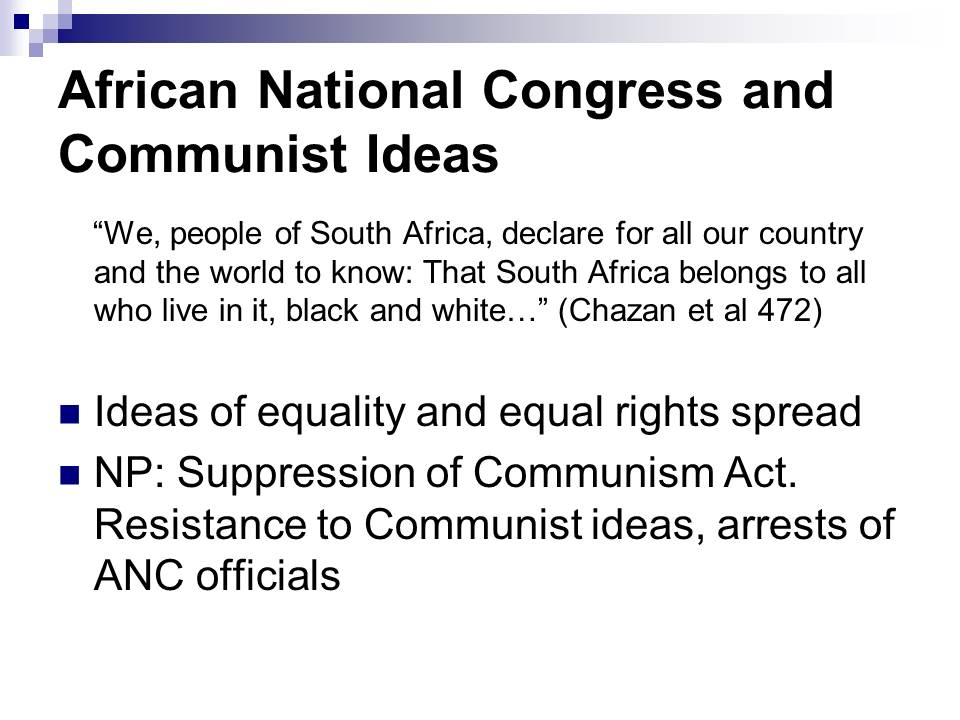
Bantustans: Segregation Is Aggravated
Bantustans: special territories of South Africa’s lands (about 13 per cent) are selected for forcing black citizens to live on.
Bantustans are presented as “independent sovereign homelands” (Chazan 473).
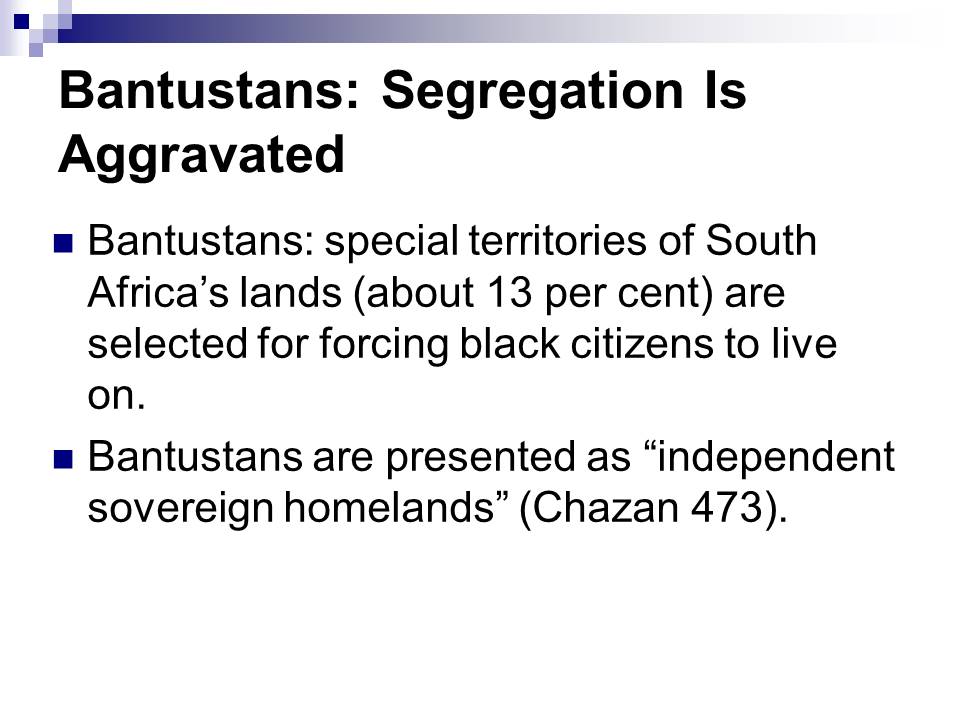
1970s: Black Rebellion
Growing unrest, activization of black movement.
Black citizens organize strikes and demonstrations.
The state reacts with severe restrictions and force. Hundreds of black people die during the demonstrations.

1983: Separate Chambers for “Coloureds”
1983: the for-whites-only referendum is held. Blacks and Asians are given opportunity to create separate chambers as representative bodies in the parliament, though not included into the parliament itself.
The new scheme caused unrest and boycotts among blacks and Asians.

1980s: “There Could no Longer Be a White Government”
The late 1980s: changes in the world, collapse of the USSR and communist regimes in European countries.
The Afrikaners’ superiority becomes impossible. “There could no longer be a white government and the head of government did not necessarily have to be white” (Chazan et al 476).
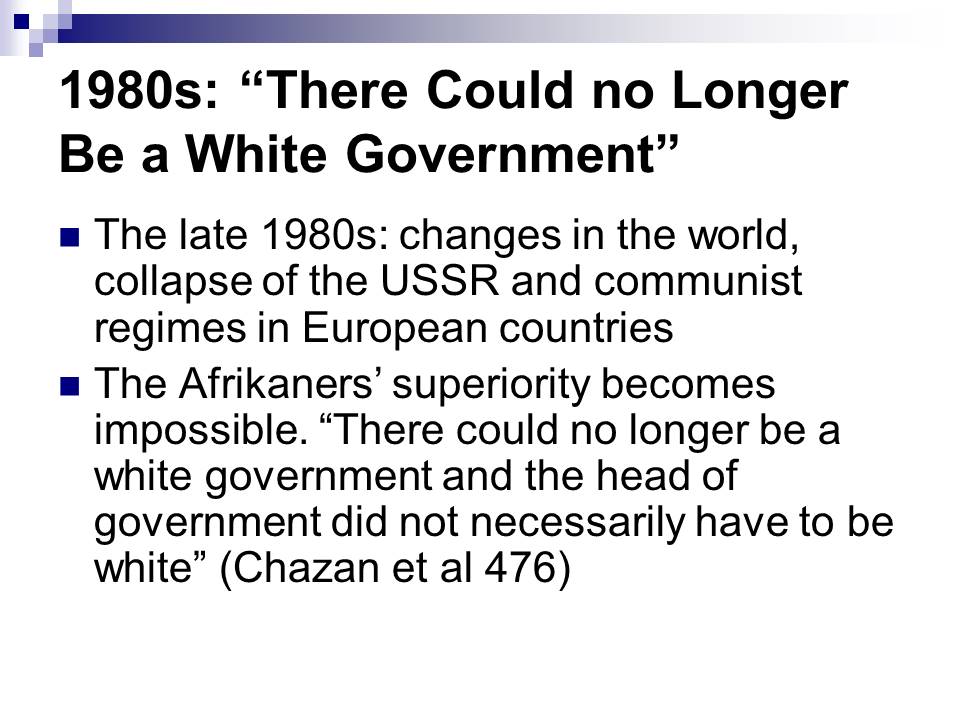
Early 1990s: End of Segregation. Paradox
South Africa state and NP are fractured; despite existing opposition, the negotiation between blacks and whites takes place.
Despite the negotiation begins, paradoxically, the society suffers from political violence.
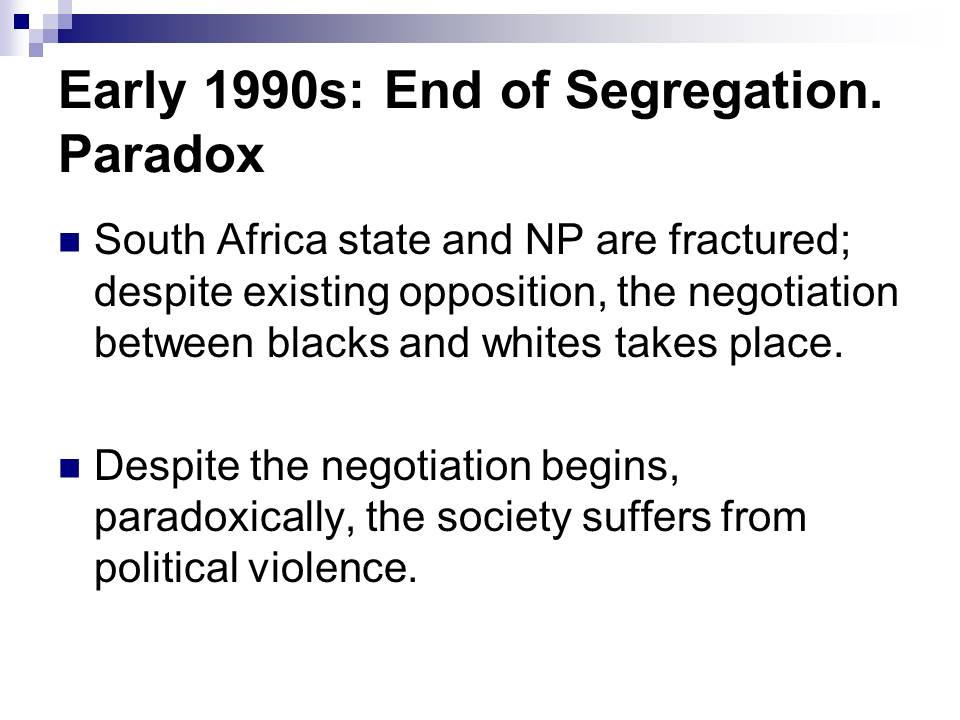
CODESA and End of Apartheid
To settle the constitutional conflict and to advance negotiations between NP and ANC, CODESA is organized.
Despite the conflicts have not finished, several breakthroughs have been made.
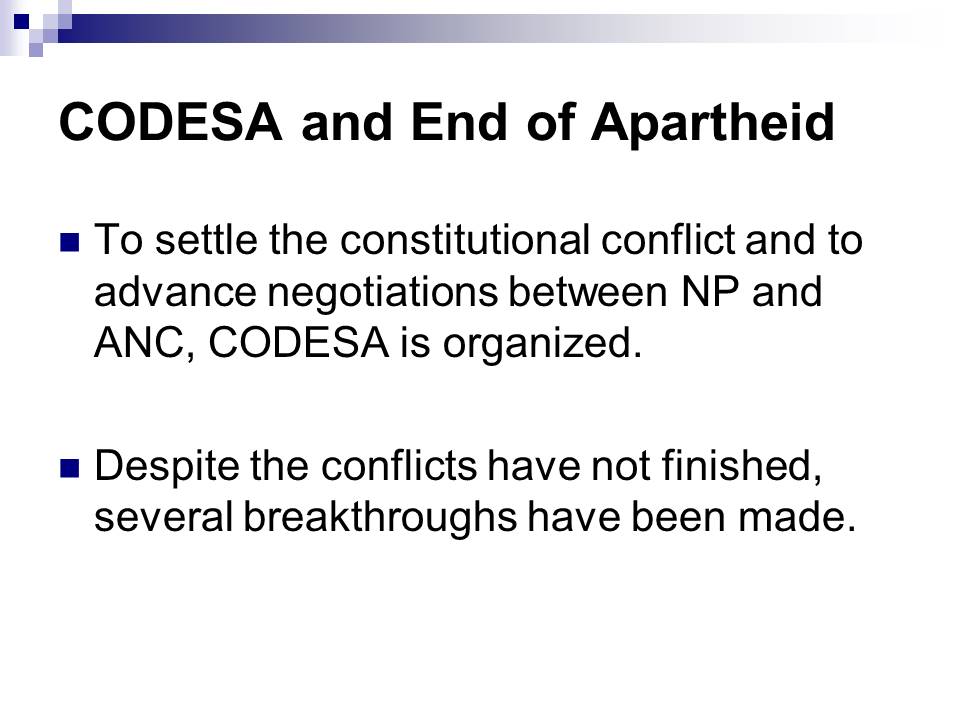
1992-1993: Finding Compromise
The compromise between NP and ANC begins to take shape.
1993: public agreement is demonstrated.
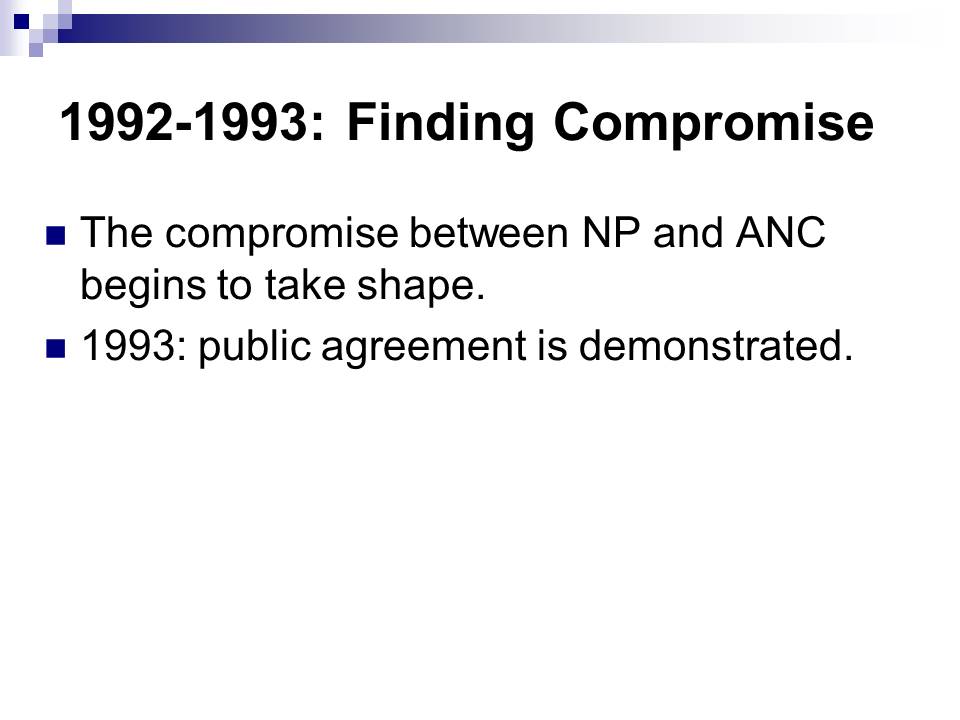
April 1992-93 Elections: Conflict Again
The elections are accompanied with struggles and boycotts. ANC wins with 62.6 per cent.
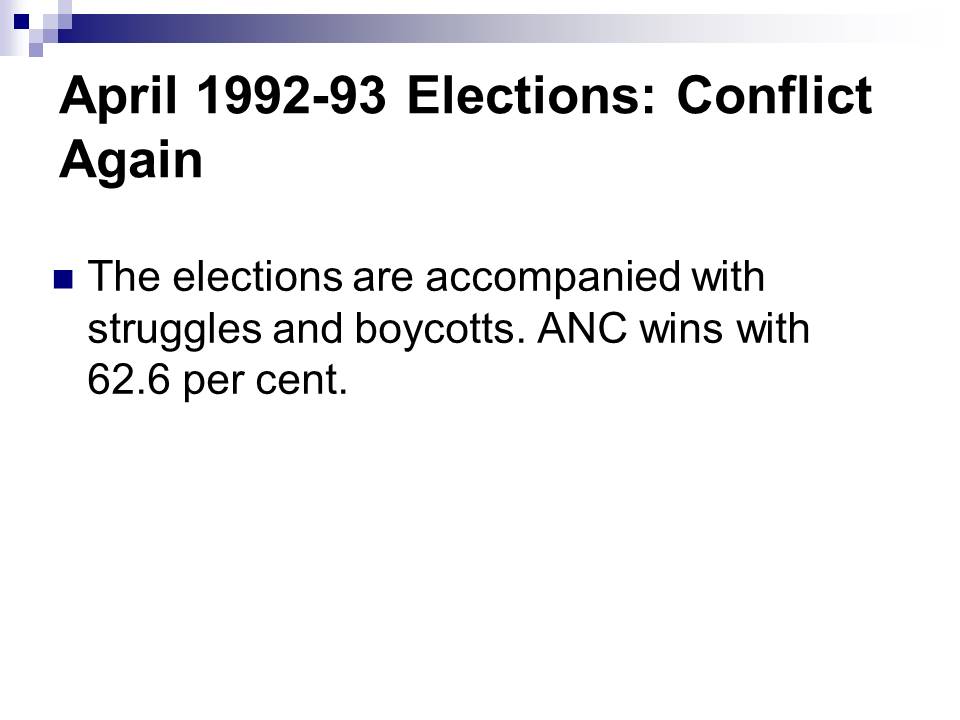
1990s: Changes in the Society
The significant gap between rich and poor still exists.
Living standard begins to improve.
Economy grows, but unemployment is still high.
Attention is drawn towards human rights violation.
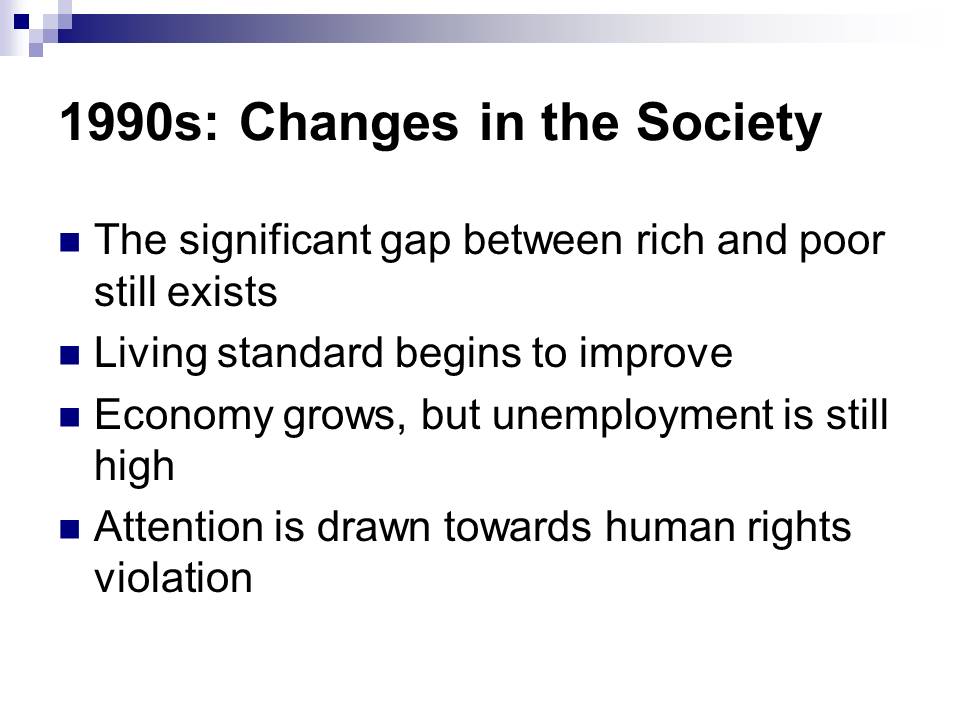
Today
South Africa has substantial prerequisites for building democracy and strong economy.
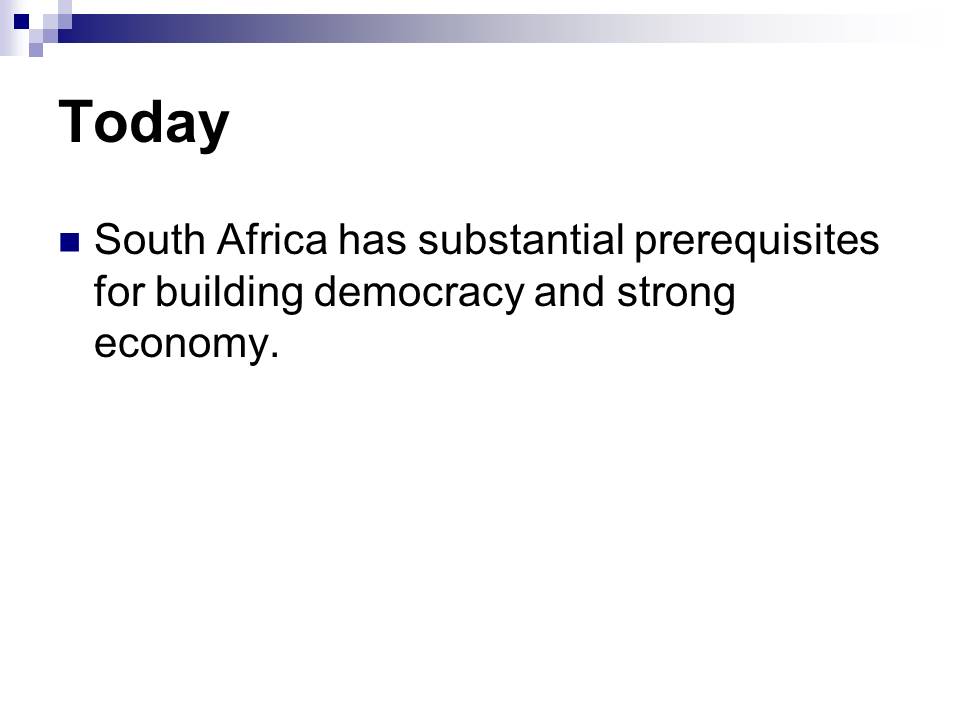
Works Cited
Abdi, Ali A. Culture, Education, and Development in South Africa: Historical and Contemporary Perspectives. Westport, CT: Bergin & Garvey, 2002. Print.
Chazan, Naomi, et al. Politics and Society in Contemporary Africa. 3rd ed. USA: Lynne Rienner Publishers.
Lodge, Tom. Politics in South Africa: From Mandela to Mbeki. Bloomington: Indiana University Press, 2003. Print.